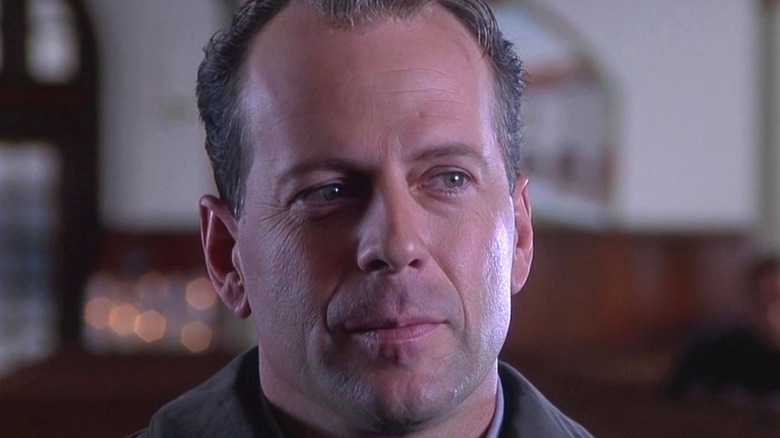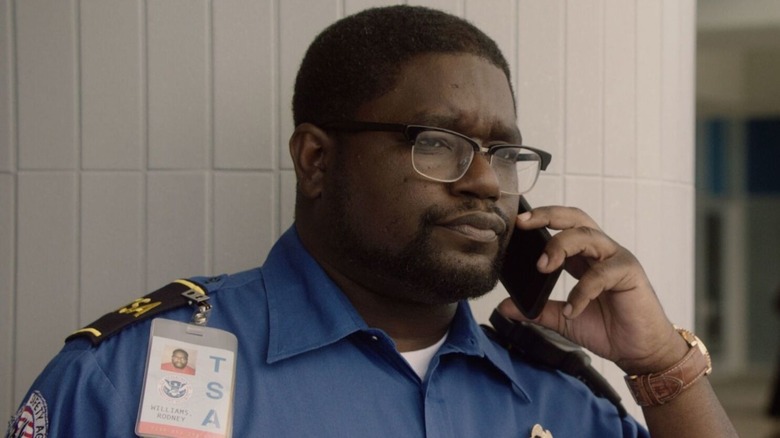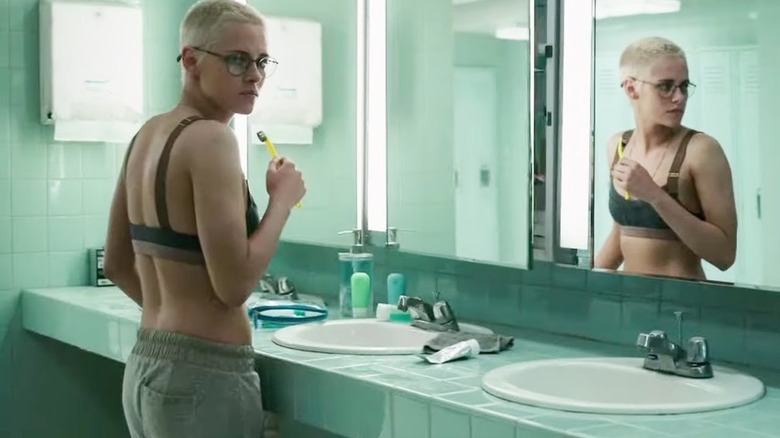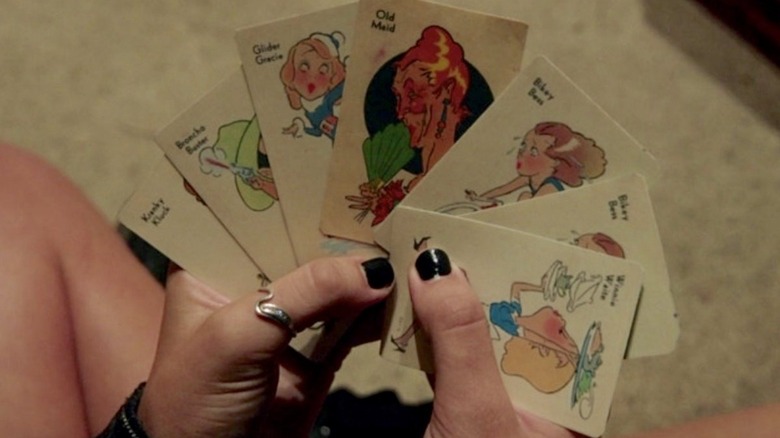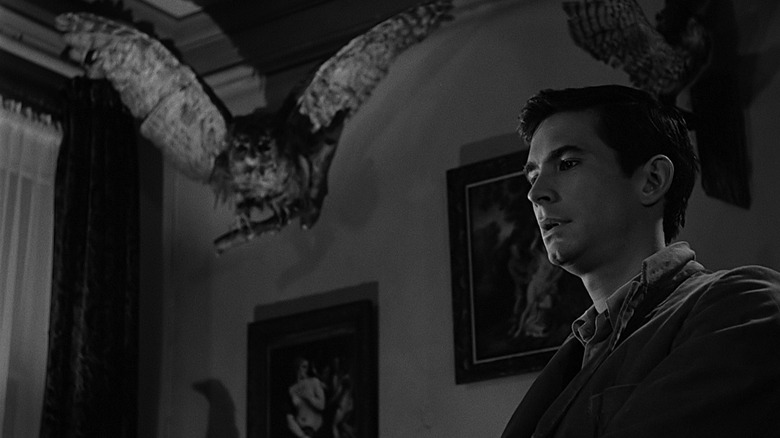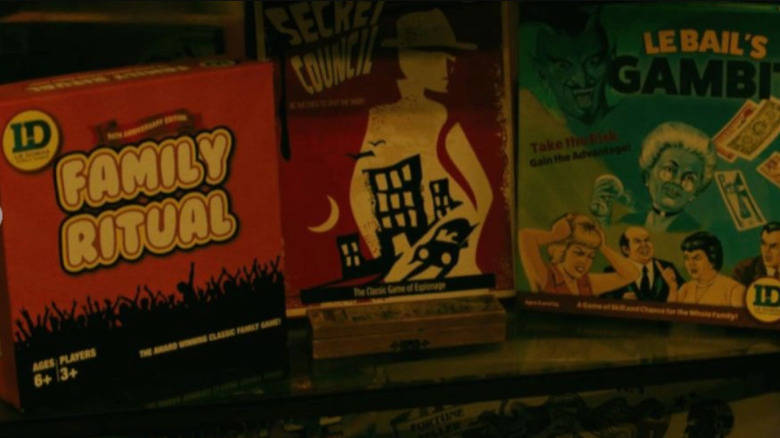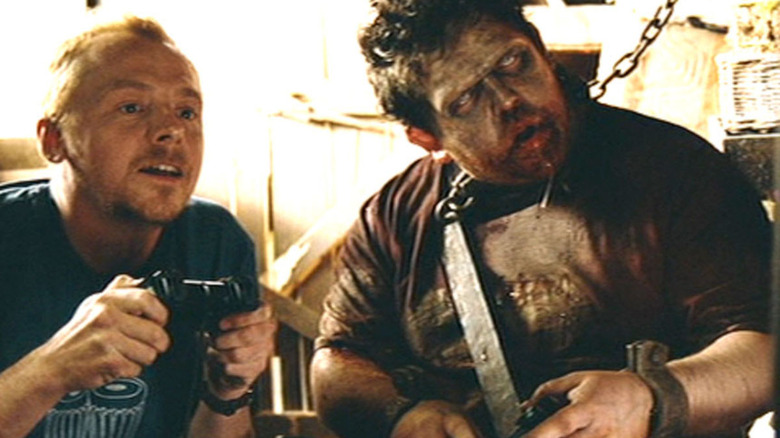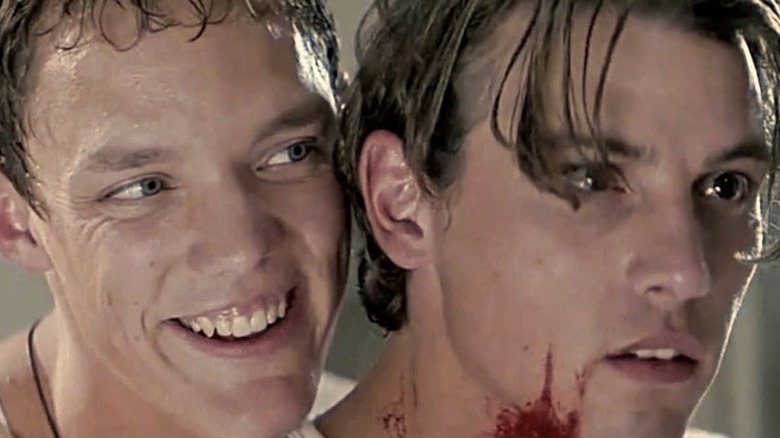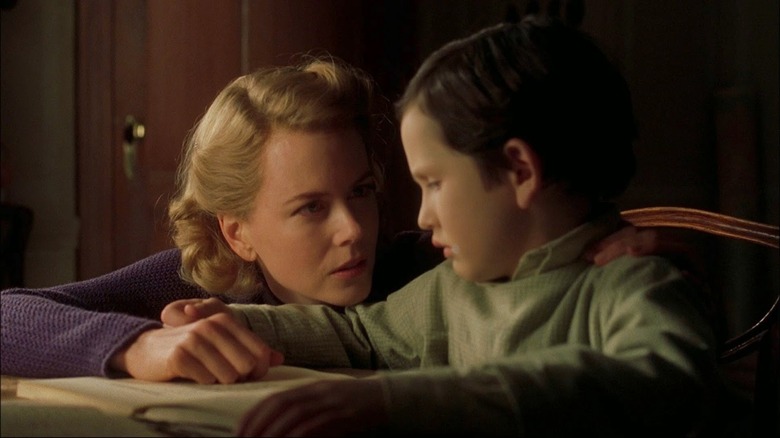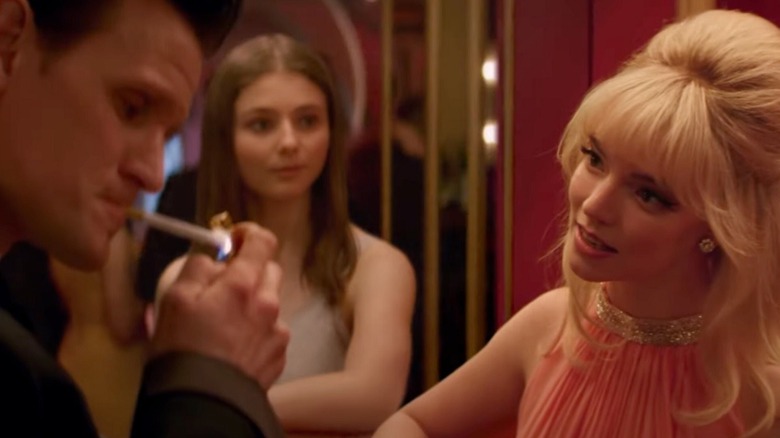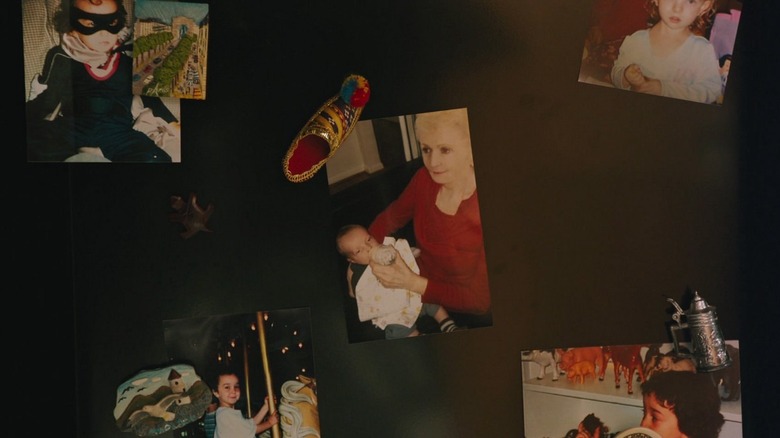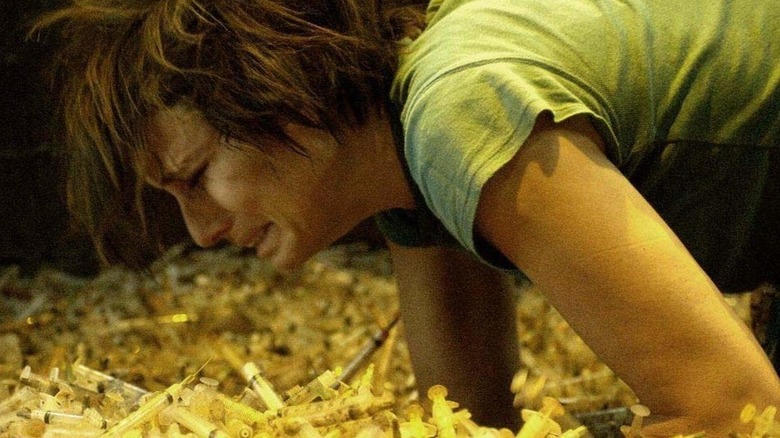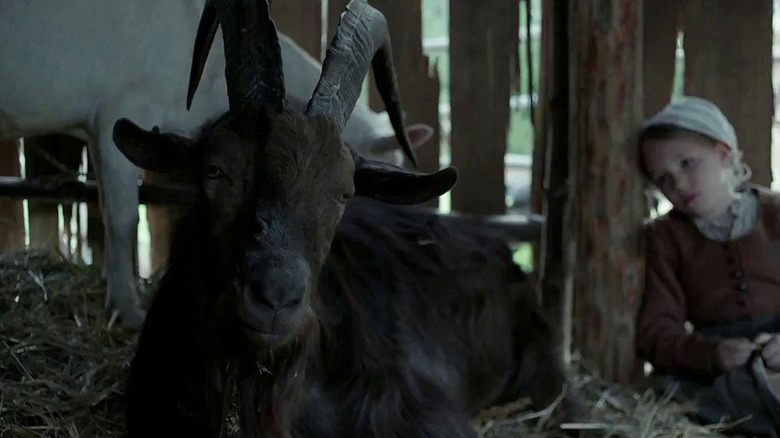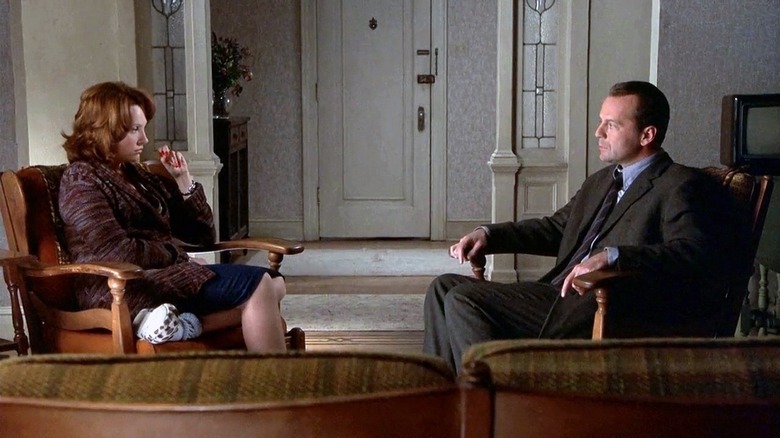Horror Movies That Spoiled Their Endings Early On And Nobody Noticed
Many people love a good horror movie, and with good reason. While traditional movies are all about the main characters winning against the odds at all costs, horror films upturn the formula by putting most or all of its characters into real danger. Not everyone comes out alive at the end of a horror film ... sometimes not even the main character. It is this element of the unexpected that can turn a good horror movie into a great one.
Horror is all about surprise — shocks, scares, and twist endings are what keep fans coming back for more. Perhaps the only thing better than a horror film with a totally unexpected ending is one that foreshadows that ending in subtle ways. This adds a new layer to the film, so that if you re-watch it, you can pick up on the small clues littered throughout that hint at what was coming all along. It's not easy to pull this off convincingly and takes a great deal of effort and forethought, but when it all comes together, it can elevate a great horror film to something even better.
Over the years, a number of talented filmmakers have risen to the challenge to deliver horror movies that not only end with a twist, but that also conclude in a way that makes sense thanks to various clues interspersed in the story leading up to it. Here are the horror features that made their ending clear from the start, if only the audience had known where to look.
Note that there are massive spoilers ahead.
Get Out has a joke hinting at the ending
Few horror movies in recent times have had as much of an impact as the 2017 low-budget feature "Get Out." The movie signaled the arrival of a bold new voice in its writer-director Jordan Peele, who brought a socially conscious approach to the horror genre. Peele created a skillful tale of suspense and tension set against the backdrop of race and class privilege in a way that audiences hadn't quite seen before.
The film follows Chris (Daniel Kaluuya), a young man who goes to meet the family of his girlfriend Rose (Allison Williams) for the first time. It's always stressful to meet the parents, and it's especially so for Chris, who discovers that Rose's white liberal family doesn't know that he's Black. As Chris tries to navigate the world of Rose's family, he finds out that there's much more to these people than meets the eye.
At the end of the movie, we discover the big reveal: A group of powerful white elites have been surgically transporting their brains from their elderly bodies into unwilling young Black candidates. While this conspiracy is revealed to Chris in the third act, it was already hinted at to him and the audience at the start of the narrative.
In the beginning of "Get Out," Chris chats on the phone with his best friend and TSA agent Rod Williams (Lil Rel Howery). While discussing his job and his paranoia regarding the people who come to the airport, Rod states, "Watch, Chris, the next 9/11 is going to be on some geriatric sh*t." It's one of Rod's many funny lines, but there's more to this seemingly light-hearted moment, since elderly people actually are at the forefront of the brain-transplant conspiracy at the end of the film.
Underwater shows a spider
Arguably, the major box office success of "A Quiet Place" and its sequel has brought the sub-genre of survival horror back into the mainstream. However, an entry to this sub-genre that slipped under the radar was 2020's "Underwater." Although it was a riff on both "Alien" and H.P. Lovecraft's "Cthulhu" mythology, "Underwater" managed to take these influences into new and interesting directions.
The movie takes place in an underwater drilling facility at the bottom of the Mariana Trench. A sudden earthquake brings disaster, as the crew tries desperately to escape the failing facility, all while being attacked by a group of creatures never before seen on Earth.
Near the end, we learn that the creatures are the spawn of a massive Cthulhu-esque beast that had been hibernating at the bottom of the trench, which was awakened by the drilling activity of the crew members. Rob Hunter at Film School Rejects notes that — based on the film's commentary track — an earlier shot of a spider in the sink at the underwater facility foreshadows that other creatures alien to the environment were also lurking nearby in the trench.
It Follows has an important game
2014's "It Follows" was an odd entry into the horror genre. While the film has some elements of a slasher horror flick, it takes a new approach to the conventions. Typical slashers rely on a scary-looking villain, who hacks and slashes through the film, but "It Follows" relies on making the villain a psychological threat rather than a physical one.
"It Follows" centers around a curse that afflicts a group of young people, who belong to the same extended social circle. The curse gets passed from one person to the next, and it takes the form of a creature — in the guise of an ordinary person — that follows the victim until it kills them. This creature is only visible to the person destined to be killed by it and the first time that the film's protagonist Jay (Maika Monroe) sees the manifestation of this curse, it's in the form of an old woman walking towards her in the hospital.
It is later revealed that the curse cannot be fought or broken, but can only be passed on from one victim to another through sexual intercourse. This revelation echoes a scene from early on in the movie when a group of children are playing a card game, where the goal is to keep passing a card from one player to the next, so you don't get stuck with the "Old Maid" card. Sound familiar?
Psycho has a birds motif
Alfred Hitchcock's 1960 classic "Psycho" is arguably one of the most famous and best horror movies of all time. It has become such an enduring part of pop culture and its story is so well-known that new audiences might not realize that during its initial release, the film relied heavily on the element of surprise to scare viewers.
The movie takes place at the nondescript Bates Motel. At first, it seems as though the motel is being terrorized by the psychotic mother of the owner, who uses a knife to kill visitors before retreating to her room upstairs. In the end, however, it is revealed that the mother has been dead all along, and the crimes were committed by her son Norman (Anthony Perkins), dressing up as her.
The reveal that Norman is the one behind the murders came as a huge shock to audiences when the movie was first released. But the fact that Norman is the killer is actually suggested early on. Norman's first victim is a woman named Marion Crane (Janet Leigh), whose surname is that of a type of bird. Norman is shown to be a keen taxidermist with a penchant for killing and stuffing birds, something he then proceeds to do to Marion as well.
Ready or Not makes board games the main plot
2019's "Ready or Not" relies less on its horror elements to entertain audiences and more on a fast, frenetic pace of action and gory special effects. There is an almost child-like quality to the straightforward plot of the movie, which is echoed in the child board games that spell out its entire plot at the start.
"Ready or Not" puts the spotlight on the powerful and wealthy Le Domas Family Games company. The family made its fortune on the back of some of the most popular board games in the world. Many of those games are seen together at the start of the movie, and these include "Family Ritual," "Secret Council," and "Le Bail's Gambit."
Together, the three board games reveal the film's basic plot to the audience. Grace (Samara Weaving) has just married into the Le Domas family, and discovers that she must participate in a secret "family ritual." This ritual has been passed down through the generations thanks to a "secret council" held between Le Domas ancestor Victor and a mysterious man named Le Bail, who demanded that Victor and his family take a risk or "gambit" in exchange for their wealth. Grace is now forced to play these games, and has until sunrise to hide from her new family, while they hunt her down and try to kill her. If she wins, she will take over as the new head of the Le Domas clan, and all of this is laid out in just a few board games at the beginning of the film.
Shaun of the Dead foretells the fate of Ed
Not every horror movie is interested in sending shivers down your spine. Some horror films bend towards comedy, and one of the best examples of that hybrid is 2004's "Shaun of the Dead." The film is considered one of the greatest, if not the greatest zombie comedy movie ever made, and with good reason.
With a sharp script and excellent direction by Edgar Wright, "Shaun of the Dead" tells the story of a zombie outbreak in London. At the center of the pandemonium is middling salesman Shaun (Simon Pegg), who lives the life of a slacker with his friend Ed (Nick Frost). Their lives are turned upside down after the zombies attack, and the duo become unlikely heroes of the apocalypse.
Unfortunately by the end of the movie, Ed had been bitten by a zombie and turned into one of the undead. Rather than eliminating his best friend, Shaun elects to keep Ed tethered and hidden in his shed, where they can still play video games together. This climax has a callback in one of the earlier scenes in the movie, when Shaun has an argument in which he tells Ed that the latter should live in the shed like an animal.
Scream gives the villains intro songs
Wes Craven's 1996 classic "Scream" is considered one of the most important slasher — and horror — movies ever made. This isn't just because of its quality, but also because of the influence it had on the genre, which has lasted for decades (via Vox). The movie is extremely self-referential, as it incldues many fourth-wall breaking lines and comments on the slasher genre as a whole.
It also has a pretty great twist on the classic "Who is the real killer?" mystery that many such films try to pull off. In the end, it is revealed that the "Ghostface killer" is not just one, but two culprits: Billy (Skeet Ulrich) and Stu (Matthew Lillard). This twist allows the story to make Billy seem like a red herring at the start, before making him one of the actual killers in the end.
As effective as the misdirection is, some clever musical cues in the beginning let you know from the start that Billy and Stu are the killers. For Billy's intro, Blue Öyster Cult's "Don't fear the Reaper" can be heard in the background. Meanwhile, just before Stu's girlfriend Tatum (Rose McGowan) gets killed, the song playing in the background is Republica's "Drop Dead Gorgeous." The song's lyrics include "I know my ex-boyfriend lies, oh he does it every time, it's just his permanent disguise," which is a pretty accurate description of Stu.
The Others lets you guess the ending
Not every twist ending in a horror movie is meant to electrify the audience. Sometimes, the final reveal is heartbreaking, and ends the film on a downer, rather than terrifying note. Case in point is Alejandro Amenábar's 2001 supernatural psychological horror, "The Others," which stars Nicole Kidman as Grace Stewart.
Grace is a single mother, who lives with her two children in a big country house after the end of World War II. One day, Grace and her family start experiencing a series of supernatural events that point to the presence of invisible forces. The unknown forces claim that the house belongs to them. This forces Grace to fight back against the unseen interlopers, only to discover by the end that she and her children were the ghosts all along.
This dramatic conclusion flips the way you view the movie entirely on its head. But there is actually a major foreshadowing before the big reveal about the death of Grace's family. All throughout the movie, Grace has persistent migraines, while her children suffer from irregular breathing. These afflictions turn out to be remnants of the tragedy that took their lives, when Grace smothered her children to death and then killed herself with a shotgun.
If you or anyone you know is having suicidal thoughts, please call the National Suicide Prevention Lifeline at 1-800-273-TALK (8255).
Last Night in Soho shows you the killer
After making his name in horror with the comedic "Shaun of the Dead," filmmaker Edgar Wright returned to the genre with a more serious offering with 2021's "Last Night in Soho." Wright takes viewers back in time to 1960s London to reveal the truth of the era in all its of dark and murky glory.
Ellie (Thomasin McKenzie) is able to time travel and jump between the 1960s and present. In the '60s, Ellie meets Sandie (Anya Taylor-Joy), an aspiring singer, who turns to prostitution before being killed by her manager. However, in the present, Ellie discovers that Sandie in fact is the one who killed her manager and many other men. In fact, she survived well into her old age, and is Ellie's landlady, Ms. Alexandra Collins (Diana Rigg).
The twist of Sandie's present-day identity is actually hinted at several times throughout the movie. The landlady's bitter attitude towards men — such as refusing to let Ellie have any men over — reflects the younger Sandie's negative experiences. Additionally, there's the bad smell in her house, which is said to be coming from the drains. In fact, it's from the dead bodies that Sandie had hidden away in the floorboards. Finally, at one point, Ms. Collins straight up tells Ellie that she would have killed John, Elli's date, if she had caught him trying to force himself upon her young tenant.
Hereditary reveals the main conspiracy
Ari Aster is considered one of the brightest stars of the horror genre, despite having only made two full-length features so far. Aster made his directorial debut with 2018's "Hereditary," where he showed an uncanny mastery of the genre by infusing many levels of dread and terror into the lives of a regular suburban family.
The story centers around Annie Graham (Toni Collette), who lives with her husband, son, and daughter in a nondescript neighborhood. The passing away of Annie's mother kicks off a chain of events that culminate in the death of Annie's daughter. Their family becomes fractured, as its members start experiencing supernatural phenomena believed to be associated with the daughter's spirit. In the end, it is revealed that the occurrences are the result of a secret society formerly led by Annie's mother, who are trying to summon a demon to inhabit the body of Annie's son.
This plot twist is unexpected, but it is also foreshadowed in an early scene. We discover that Anne had a brother, who killed himself at a young age, and left a note behind that accused their mother of "putting people inside him." At the time, the note was considered a sign of the brother's mental illness, but the final events of the film prove that in fact, Annie's mother had previously unsuccessfully tried to place the demon inside her son.
If you or anyone you know is having suicidal thoughts, please call the National Suicide Prevention Lifeline at 1-800-273-TALK (8255).
Saw II has the villain hiding in plain view
The "Saw" franchise started out with a great deal of promise, before petering out with a few less-than-stellar entries in the series. But the first two "Saw" movies are still held up as great examples of slasher gore done right, as they use a strong story and interesting characters to explore the main themes of the franchise in a compelling manner.
"Saw II" provides a singular twist to the narrative established by its predecessor. In the original movie, the killings were carried out by a man named Jigsaw, who traps his victims in deadly games that have only one way out (two, if you include death). "Saw II" ends with the shocking revelation that Jigsaw hasn't been working alone, and his second-in-command all along has been Amanda (Shawnee Smith). Amanda is Jigsaw's former victim-turned-protégé, who has been pretending to be trapped again amongst his new victims.
The fact that Amanda was a villain the whole time is hinted at in a few subtle ways. She keeps insisting that Jigsaw is not a killer and that everyone would survive if they just played by his rules, as though she has intimate knowledge of his motivations. When she gets thrown into the needle pit, she finds the spot with the key pretty quickly, showing that she already knew where it would be. She also seems resistant to the toxin that poisons the rest of the group, all of which points to someone with a stronger relationship to Jigsaw than the others.
The Witch had a spot-on children's rhyme
Along with Ari Aster, Robert Eggers is another horror filmmaker, who showed a shocking amount of talent with his first feature, 2015's "The Witch." The movie creates many layers of tension, all without taking the focus away from the family drama at the center of the story, and the big secret revealed at the very end.
"The Witch" sees a family of 17th century English settlers being ousted from their community over a religious dispute. The proud father William (Ralph Ineson) decides to take his family to live in solitude near a forest, rather than make peace with the other settlers. Soon, William and his family begin to be terrorized by a coven of witches, whose home is in the forest.
While the witches are the main source of terror for the family, it is revealed near the end that Satan himself has been masquerading as the family's goat, Black Phillip. This twist is foreshadowed near the beginning of the movie, when the youngest children of the family sing a song for Black Phillip, whose lyrics hint at him being Satan himself and include lines like "Black Phillip, Black Phillip, a crown grows out his head" and "Black Phillip eats the lions from the lions' den." Additionally, there is a close up of the goat's eye, which shows its round pupil instead of the rectangular pupils that real goats have, hinting that the creature is a shape-shifter or at the very least, not your run-of-the-mill animal.
The Sixth Sense hides its twist in plain sight
Let's talk about what may be the most famous twist in the history of horror movies. In 1999, filmmaker M. Night Shyamalan made his directorial debut with "The Sixth Sense." The film's overwhelming critical acclaim and financial success had Shyamalan being compared to everyone from Steven Spielberg to Alfred Hitchcock, and with good reason.
The film focuses on Malcom (Bruce Willis), a psychologist, who's working with Cole (Haley Joel Osment), a little boy, who believes he can talk to ghosts. As Malcolm tries to help his young patient, he's also dealing with his own marital problems. Shyamalan expertly weaves together these dramatic and terrifying storylines, which build up to the big reveal at the end: Malcom is a ghost. Despite seeing Malcolm get shot at the start of the movie, his dead status still comes as a massive shock.
However, there are some clues that hint to his demise. For example, only the child who can speak to ghosts interacts with Malcolm throughout the movie. Malcolm also always wears the same outfit, and it's the one he had on the day he was shot. Finally, the only time that people other than Cole acknowledge Malcom's presence is by shivering when they're near him, and this type of sudden chill is associated with a ghostly presence.
